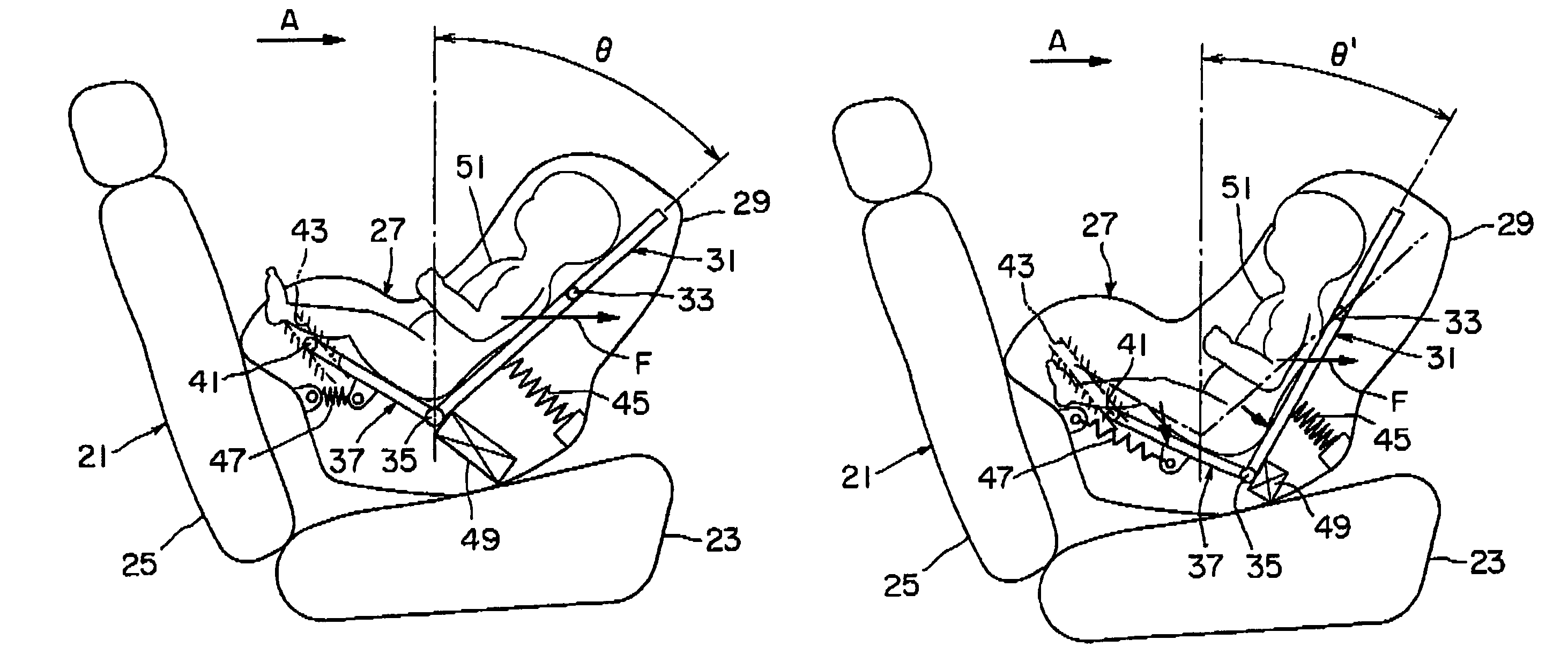Child seat
a child seat and car seat technology, applied in the direction of child seats, chairs, pedestrian/occupant safety arrangements, etc., can solve the problem of increasing the load on the newborn's shoulder, and achieve the effect of preventing an impa
- Summary
- Abstract
- Description
- Claims
- Application Information
AI Technical Summary
Benefits of technology
Problems solved by technology
Method used
Image
Examples
second embodiment
[0052]FIG. 3 is a view showing a child car seat 61 in accordance with the present invention. This child car seat 61 differs from the child car seat 27 of FIG. 1 in that the seat portion 37 is supported by a joint part 63 in the child car seat 61 of FIG. 3, while the back portion 31 and the seat portion 37 are normally supported by the urging springs 45, 47 in the child car seat 27. The other constitutions of are similar to those of the child car seat 27, respectively. Therefore, elements identical to those of the child car seat 27 are indicated by the same reference numerals respectively and their overlapping descriptions are eliminated.
[0053]In the constitution as above, when a great inertia force F is applied on the newborn 51 at a vehicle's sudden braking, the back portion 31 is subjected to a rotating force in the counter-clockwise direction about the rotating shaft 33 as a rotating center. Due to this rotating force, a force to the right direction of FIG. 4 is applied to the se...
third embodiment
[0055]FIG. 5 is a view showing a child car seat 71 in accordance with the present invention. This child car seat 71 differs from the child car seats 27, 61 of FIGS. 1 and 3 in that a force mechanism 73 is arranged in a position above the rotating shaft 33 of the back portion 31b. In this child car seat 71, though not shown in FIG. 5, the urging spring 45 and the urging spring 47 of FIG. 1 or the joint part 63 support the back portion 31 and the seat portion 37, respectively and the child car seat 71 is also equipped with the shock absorbing mechanism 49. The operations at the time of receiving an impact are also similar to those of the afore-mentioned child car seats.
[0056]This child car seat 71 with the force mechanism is fixed to the seat 21 of the vehicle by means of a seat belt 75, as shown in FIG. 7A. Then, the seat belt 75 is engaged with a belt guide 77 on a back portion of the child car seat body 29. Inside the belt guide 77, there is provided a switch 81 that drives the abo...
PUM
 Login to View More
Login to View More Abstract
Description
Claims
Application Information
 Login to View More
Login to View More - R&D
- Intellectual Property
- Life Sciences
- Materials
- Tech Scout
- Unparalleled Data Quality
- Higher Quality Content
- 60% Fewer Hallucinations
Browse by: Latest US Patents, China's latest patents, Technical Efficacy Thesaurus, Application Domain, Technology Topic, Popular Technical Reports.
© 2025 PatSnap. All rights reserved.Legal|Privacy policy|Modern Slavery Act Transparency Statement|Sitemap|About US| Contact US: help@patsnap.com



